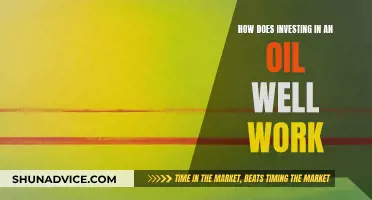
Anyone can invest, but the short answer is that only rich people can access certain types of investments. These include private equity funds, which require investors to be accredited, usually with a net worth of at least $250,000. The ultra-wealthy, or UHNWIs, are individuals with net worths of at least $30 million. UHNWIs understand the importance of savings and the basics of investing and know how to take calculated risks. They tend to diversify their investments, putting their money into stocks, mutual funds, retirement accounts, real estate, and alternative investments such as fine art, expensive musical instruments, and rare books.
| Characteristics | Values |
|---|---|
| Net worth | $30 million or more |
| Sources of wealth | Inheritance, business ownership, investments |
| Investment strategies | Diversification, calculated risks, long-term goals |
| Types of investments | Stocks, bonds, mutual funds, real estate, private equity, commodities, alternative investments |
| Financial habits | Frugality, saving, investing in network |
| Mindset | Focus on achievements, maximising time, outsourcing |
What You'll Learn

The wealthy diversify their investments
Diversification is a common strategy used by investors to reduce the risk of experiencing large losses. By spreading their investments across different assets, investors lower the chances of their portfolio being wiped out by a single negative event impacting a single holding. Diversification also aims to include assets that are not highly correlated with one another.
The wealthy, including millionaires and billionaires, tend to have diverse investment portfolios. They invest in a range of asset classes, including stocks, bonds, cash and cash equivalents, real estate, private equity, hedge funds, and alternative investments. Here are some ways in which the wealthy diversify their investments:
- Stocks and Stock Funds: Millionaires and ultra-rich investors often hold a portfolio of equity securities, which can provide passive income through dividend-paying stocks. Index funds are also popular among the wealthy as they offer diversification with minimal time management and low fees.
- Real Estate: Many millionaires start by investing in personal real estate, such as a primary home, and then expand into commercial real estate, such as office buildings, hotels, and rental properties. Real estate provides a long-term investment that retains its value over several economic cycles and offers excellent profit potential.
- Cash and Cash Equivalents: Millionaires often keep a significant portion of their wealth in cash and highly liquid assets, such as money market mutual funds, certificates of deposit, commercial paper, and Treasury bills. This provides emergency funds, helps pay off liabilities, and boosts the liquidity profile of their portfolio.
- Private Equity and Hedge Funds: Private equity and hedge funds are exclusive investment opportunities for the wealthy. Private equity funds require a high net worth and accreditation, while hedge funds pool funds to pursue short-term profits.
- Alternative Investments: The wealthy may invest in tangible assets such as fine art, vintage cars, yachts, precious metals, and intellectual property rights. These investments can provide diversification and a hedge against inflation.
By diversifying their investments across various asset classes and industries, the wealthy reduce their overall investment risk and increase their potential for long-term wealth accumulation.
Investments: Your Future's Best Friend
You may want to see also

They invest in their connections
Connections are an important part of building wealth, and the rich understand this. They know that networking and building relationships can lead to better opportunities, faster decision-making, and higher margins.
Grant Cardone, a self-made millionaire, shares that most of the real estate he owns was purchased from sellers who knew him and had confidence in his ability to close a deal. This highlights the importance of relationships in business and how they can provide an edge over other buyers who may be equally qualified.
The more someone gets to know you, the more they will trust you and believe in your abilities. This is a fundamental aspect of human psychology, as people are naturally inclined to connect with others who share common interests, hobbies, values, or culture. It provides a sense of belonging and comfort, allowing stronger connections to form.
We can see this principle in action in the workplace, where employees who connect and collaborate are able to harness collective intelligence and combine diverse perspectives to innovate and solve problems. This, in turn, can lead to positive changes in products, services, or workplace policies, resulting in a great return on investment.
Therefore, it is crucial to invest time and resources into building and maintaining the right connections. This can be done by creating an inclusive environment that fosters open discourse and constructive feedback, as well as providing opportunities for employees to connect through shared projects, learning initiatives, and social activities.
By leveraging technology and digital tools, such as virtual collaborative platforms, connections can be further strengthened, especially in remote or hybrid work environments.
In summary, building strong connections is an essential aspect of wealth creation, and the rich understand the importance of investing in their relationships to achieve greater success.
Dogecoin: Worthy Investment or Just a Meme?
You may want to see also

They are never content
Grant Cardone, a self-made millionaire, has observed that the ultra-wealthy are never satisfied with their past achievements and are always looking towards the next goal. This is a common trait among the wealthy, and it helps them to think big about future investments, business ideas, and other wealth multipliers.
Psychologists Daniel Kahneman and Angus Deaton surveyed over 450,000 US residents in 2008 and 2009 and published their results in a 2010 paper, "High Income Improves Evaluation of Life but Not Emotional Wellbeing". They found that happiness increases with income levels, but only until basic needs are met. Once an individual's basic needs are satisfied, happiness levels plateau.
In other words, the very wealthy are no happier than the upper middle class. Kahneman and Deaton break happiness into two categories: experienced happiness and reflective happiness. Experienced happiness is related to day-to-day moods, while reflective happiness is what people feel when asked to compare themselves to someone less fortunate.
Reflective happiness is what allows the rich to feel happier when asked to evaluate their wealth in comparison to others. However, this does not carry over to their day-to-day mood or experienced happiness. This phenomenon is known as the Hedonic Treadmill, where people get used to what they own and rarely reflect on their good fortune, thus remaining unsatisfied and always striving for more.
The ultra-wealthy, therefore, are never content and always strive for more. This drive to achieve more and the belief that they can always achieve more is a common trait among the wealthy and is essential to their success.
Investing: Nice People Turn Nasty
You may want to see also

They don't waste time on small tasks
While it is a common misconception that only the rich can invest, this is not the case. The ultra-wealthy are defined as ultra-high-net-worth individuals (UHNWIs) with a net worth of at least $30 million. These individuals understand the importance of savings, the basics of investing, and how to take calculated risks. They also know what simple investing blunders to avoid.
One of the habits of the ultra-wealthy is that they don't waste time trying to do everything themselves. They know that time is the only truly scarce resource and that it is impossible to buy more of it. Therefore, they maximise their time by letting go of the need to control every small detail of their business or portfolio and learn to outsource and delegate to good, smart people.
- Focus on one task at a time: Multitasking is a time-killer and prevents you from finishing priority tasks. Instead, focus on one task at a time to avoid the 'warm-up' phase of starting a new task.
- Write a to-do list: Write a short, achievable to-do list for each day, numbering tasks in order of importance. This will help you stay focused and avoid getting distracted.
- Schedule your day: Assigning specific tasks to specific times will help you stay on track and avoid procrastination. Be realistic about how long each task will take and consider your priorities.
- Block distracting websites: Use website blockers to avoid getting distracted by social media and other time-wasting sites.
- Don't start the day with emails or social media: Checking social media and emails first thing in the morning can be a procrastination tool and a source of distraction for the rest of the day.
- Check emails at designated times: Instead of constantly checking emails, set aside specific times of the day to deal with them. This will help you stay focused on your priority tasks.
- Delegate and outsource: Learn to delegate and outsource small tasks to free up your time for more important work.
By implementing these strategies, you can avoid wasting time on small tasks and improve your overall productivity and efficiency.
Robinhood: Still Relevant?
You may want to see also

They understand calculated risks
Understanding calculated risks is a key aspect of building wealth. While it may seem that only rich people invest, this is not the case. The ultra-wealthy, or ultra-high-net-worth individuals (UHNWIs), understand the importance of having their money work for them and know how to take calculated risks. They recognise that investing is about spotting potential and taking calculated risks.
So, what exactly is a calculated risk? A calculated risk is an undertaking where the chance of failure has been previously estimated or considered. It is a risk that is deemed worth taking because the potential outcome or result is highly favourable. In other words, the potential benefits outweigh the potential drawbacks. This doesn't mean that the ultra-wealthy are not afraid to take risks. Instead, they understand how to assess and manage these risks effectively.
There are several key steps to taking calculated risks. Firstly, it is essential to conduct thorough research and understand all the small details of a decision. This enables the identification of any potential red flags or issues. Secondly, it is crucial to anticipate mistakes and consider all possible outcomes, especially the negative ones. By doing so, individuals can be better prepared for any challenges that may arise. Setting checkpoints and goals is another important aspect of taking calculated risks. This involves establishing parameters to monitor the level of risk and ensure it aligns with one's risk tolerance.
Additionally, the ultra-wealthy understand the importance of diversifying their investments. While they may initially focus their resources on their own projects, they eventually diversify as their earnings grow. This diversification can take many forms, including investing in stocks, funds, real estate, private equity, and more. By diversifying their investments, the ultra-wealthy reduce their exposure to potential risks and increase their opportunities for growth.
In conclusion, understanding calculated risks is a critical component of building wealth. The ultra-wealthy recognise that investing involves taking risks, but they approach these risks in a strategic and informed manner. By conducting thorough research, considering all outcomes, setting checkpoints, and diversifying their investments, they increase their chances of success and effectively manage their risk exposure.
China's Bubble: Global Investment Risk
You may want to see also
Frequently asked questions
No. Anyone can invest, and many millionaires keep their money in investments that any investor can access.
High-net-worth individuals put money into different classifications of financial and real assets, including stocks, mutual funds, retirement accounts, real estate, bonds, private equity, and hedge funds.
Rich people tend to have a plan prior to investing, which involves market research and exploration of timelines. They also have multiple social circles, which provide information about where and how to invest.
Ultra-high-net-worth individuals (UHNWIs) understand the importance of savings and investing, and know how to take calculated risks. They do not invest only domestically or in intangible assets, and they do not try to keep up with their neighbours or compare themselves to others. UHNWIs also periodically rebalance their portfolios to achieve the right mix of stocks and bonds.
Many people assume that rich people have special places to keep or manage their money that others do not have access to. This is not usually the case.







